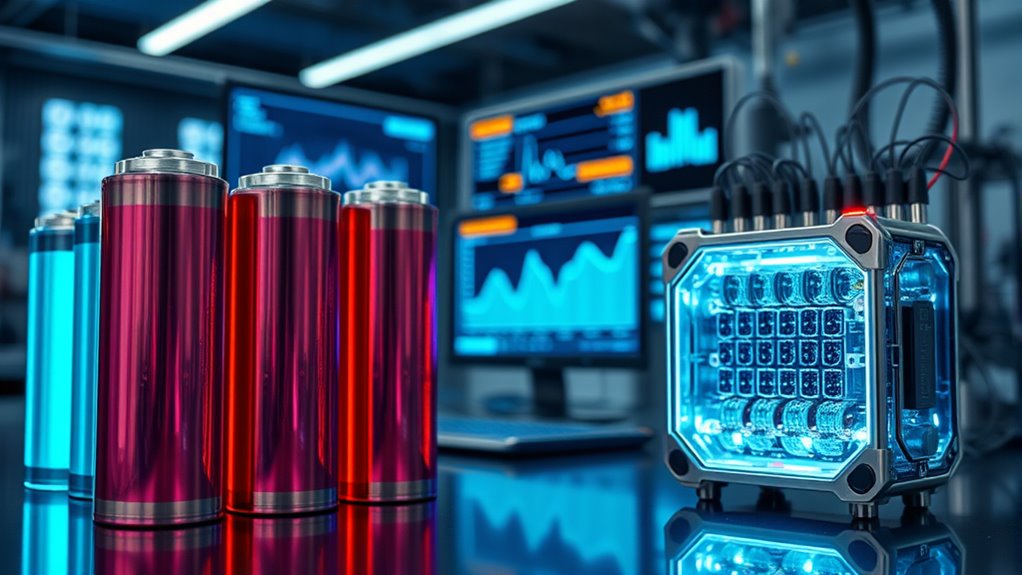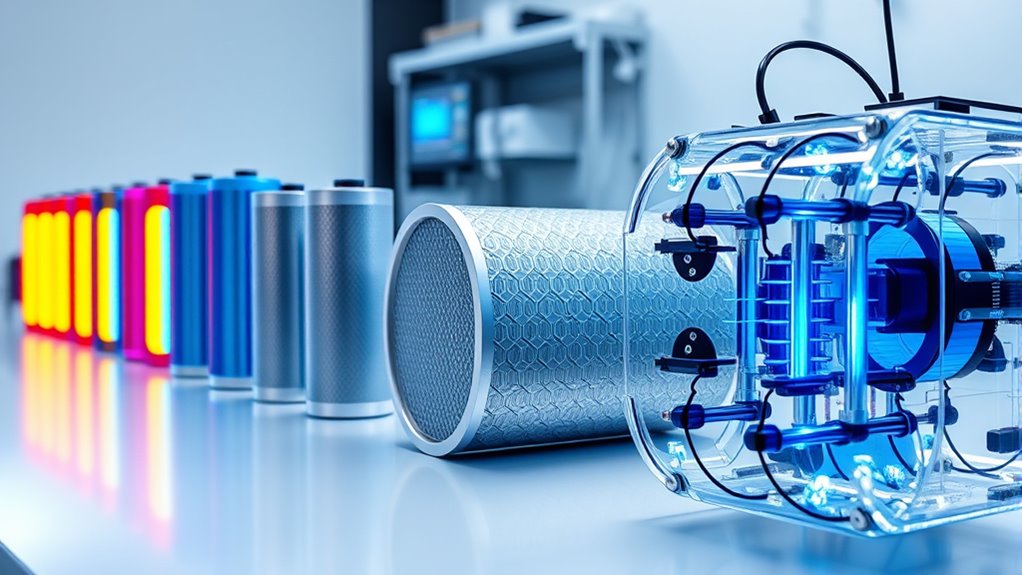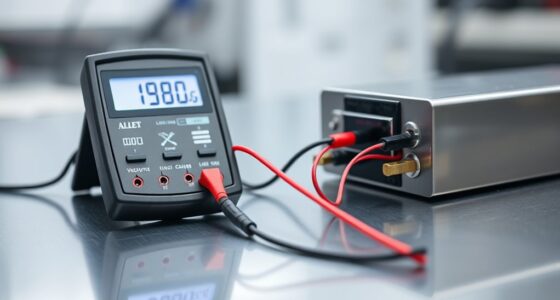Batteries store large amounts of energy for long durations, making them ideal for steady power supply but they degrade over time and can be affected by environmental factors. Supercapacitors charge and discharge rapidly, providing quick bursts of power with high cycle life, but they hold less energy overall. Fuel cells generate continuous power from chemical reactions, suited for large-scale and long-term use but require complex infrastructure. To understand which fits your needs best, explore the differences in more detail below.
Key Takeaways
- Batteries provide long-term energy storage with high energy density but have limited cycle life and sensitivity to environmental factors.
- Supercapacitors deliver rapid charging and discharging with high cycle durability but store less energy, suitable for short bursts.
- Fuel cells generate continuous, large-scale power from chemical reactions, ideal for steady energy supply but require complex infrastructure.
- Supercapacitors excel in quick power delivery and high cycle life, while batteries are better for sustained energy supply.
- Fuel cells are optimal for large-scale, long-duration energy needs but are more expensive and environmentally sensitive.

Have you ever wondered how we can store excess energy generated by renewable sources like solar and wind? This is where energy storage technologies come into play, helping us balance supply and demand. Among these, batteries and supercapacitors are popular choices, each with unique strengths and limitations. When considering batteries, one of the key factors is battery lifespan. You need to think about how long your battery will last before its capacity diminishes. Lithium-ion batteries, for example, typically last between 5 to 15 years, depending on usage and maintenance. They’re great for storing large amounts of energy over longer periods, but their lifespan can be affected by factors like temperature, charge cycles, and depth of discharge. Supercapacitors, on the other hand, shine with their supercapacitor efficiency. They can charge and discharge rapidly, often in seconds, and withstand hundreds of thousands of cycles without significant degradation. This makes them ideal for applications requiring quick bursts of energy, such as stabilizing power grids or electric vehicles during acceleration. Additionally, supercapacitors are often used in electric dirt bikes and other high-performance electric vehicles due to their ability to provide rapid power delivery. However, supercapacitors usually store less energy per unit volume compared to batteries, which limits their use to short-term energy buffering rather than long-term storage.
While batteries excel in providing steady, sustained energy over hours or days, supercapacitors are unmatched in delivering quick power. The efficiency of supercapacitors is also notable—they can recover and deliver energy with minimal losses, making them highly effective in fast-charging scenarios. However, their lower energy density means they aren’t suitable for replacing batteries in applications where longer-term storage is essential. Fuel cells offer a different approach altogether, converting chemical energy directly into electricity, often using hydrogen. They are highly efficient and capable of producing large amounts of energy continuously, making them suitable for power plants or long-distance transport. But they require a steady supply of fuel and involve complex, expensive infrastructure for hydrogen production, storage, and distribution. Plus, fuel cells tend to be more sensitive to environmental conditions, and their lifespan can be affected by material degradation over time.
Frequently Asked Questions
What Are the Environmental Impacts of Each Energy Storage Technology?
You should consider that batteries have a significant environmental footprint due to resource extraction and disposal challenges, impacting resource sustainability. Supercapacitors generally have a lower environmental impact, as they use fewer toxic materials and last longer. Fuel cells can be environmentally friendly if powered by renewable fuels, but their production involves rare materials. Overall, each technology’s environmental footprint depends on materials used and how sustainably resources are managed.
Which Technology Offers the Fastest Charging and Discharging Capabilities?
Oh, the thrill of waiting hours to recharge? Not with supercapacitors! They offer lightning-fast charging and rapid discharging, making batteries look sluggish. If you need instant power, supercapacitors blast energy in and out in seconds, perfect for quick bursts. Batteries lag behind, taking ages to recharge and slowly releasing energy. Fuel cells, meanwhile, prefer a more laid-back approach. So, for speed, supercapacitors reign supreme.
How Do Costs Compare for Large-Scale Deployment of Each Option?
You’ll find that cost analysis varies considerably for large-scale deployment. Batteries tend to have higher initial costs but are more established, easing deployment challenges. Supercapacitors offer rapid cycling but can be expensive for large volumes. Fuel cells have promising potential but face high costs and complex infrastructure, making deployment challenging. Ultimately, your decision depends on balancing upfront expenses against long-term efficiency and feasibility in your specific application.
What Are the Safety Considerations Associated With Each Technology?
You should consider that batteries pose chemical hazard risks and require careful handling to prevent leaks or fires, especially if damaged. Supercapacitors generally have high thermal stability, making them safer, but they can still pose electrical hazards if mishandled. Fuel cells involve combustible fuels and chemical hazards, requiring proper ventilation and safety protocols. Overall, always prioritize safety measures to mitigate chemical hazards and maintain thermal stability across these technologies.
How Scalable Are Batteries, Supercapacitors, and Fuel Cells for Different Applications?
You’ll find that batteries scale well for large applications like grid storage but face scalability challenges due to cost and size constraints. Supercapacitors excel in rapid charge-discharge cycles, but deployment limitations include lower energy density, making them less suitable for long-term storage. Fuel cells can be scaled for various uses, yet their scalability is hindered by high costs and complex infrastructure needs, affecting widespread deployment.
Conclusion
Think of energy storage options as a toolbox—batteries, supercapacitors, and fuel cells each have their own strengths. Batteries are like reliable backpacks, great for long journeys, while supercapacitors act as quick-draw pocket knives, delivering rapid bursts of power. Fuel cells are like fuel tanks, offering sustained energy over time. By understanding their unique roles, you can choose the right tool, ensuring your energy needs are met smoothly—like a well-oiled machine powering your future.










